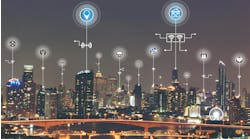Building owners and operators may think they have unique reasons for seeking out innovative technologies to incorporate into their facilities. But the fact is that certain patterns emerge when taking a broad view of today’s smart building technology goals.
To that end, let’s look at five reasons why building owners are becoming increasingly interested in solving common issues and the types of smart buildings technologies that could be used to solve them.
1. Reducing energy consumption
Trimming back on operational costs has long been a priority for building managers. A reduction of electricity usage is usually part of this goal. As commercial property electricity costs continue to rise, many are looking to technological solutions to help automate the following energy consumption processes:
- Identify areas where electricity is being wasted.
- The use of IoT sensors to detect where occupants are located within a building and deliver HVAC and lighting in a targeted manner.
- Integration of in-building renewable energy sources including solar, geothermal, wind and bioenergy.
2. Building/occupant work environment optimization
The COVID-19 pandemic has given building owners the opportunity to review and potentially rethink how tenants and other occupants use and interact with building facilities in a more efficient manner. Many have concluded that technology can be integrated within private tenant suites and common/shared areas to help make better use of the available building space.
Specialized “space sensing” devices are being installed throughout buildings to detect occupant counts and how long occupants remain in certain areas. Based on this collected data, building occupancy heat maps can be created to identify high and low traffic locations. Areas with little traffic can then be reworked to help optimize areas where occupant congestion is occurring.
3. Proactive maintenance and monitoring
Early adopters of smart building sensors and platforms have grown increasingly wary of the technologies they’ve integrated because they have become far too cumbersome and time consuming to manage. That’s why the popularity of building management and AI-backed automation platforms has become such a popular topic as of late. The ability to consolidate multiple IT and OT technologies into a single management platform is becoming an absolute must as more and more technology is being added.
4. Occupancy health compliance
While the health of building occupants has always been a concern, the pandemic has created a surge of interest regarding how technology can be leveraged to better monitor and manage health-related factors such as physical safety, air quality, social distancing and sanitation.
As customers and tenants return to commercial properties in 2021 and 2022, it has become vital to reassure occupants that their health safety is a top priority -- and that indoor air is free of pathogens, dust and organic compounds that could impact health. Additionally, common areas must be monitored to ensure that social distancing regulations and the cleanliness of shared spaces and components are closely watched and regularly sanitized.
The following technologies are often used to achieve these health compliance goals:
- AI-based surveillance cameras or sensors to assist in occupant counts and/or temperature screening.
- Air quality sensors with real time feedback and alerting.
- Automated air cleaners and ventilation controls.
- Humidity sensors.
- UV lighting integrated into HVAC systems.
- Air pressurization systems to isolate and protect clean spaces form contaminated.
5. New revenue generation opportunities
Smart building technologies and infrastructures should not always be thought of solely from a cost savings or space optimization perspective. For buildings that lease space to tenants, many technologies can benefit an occupant’s overall experience when using and interacting with various in-building services and amenities. These benefits can translate into higher rent rates charged back to the tenant.
The other revenue generation potential is to offer tenants secure access to the underlying wired and wireless network infrastructure that supports in-building technologies. Instead of requiring that each tenant obtain their own broadband internet and local network connectivity through traditional internet service providers, the building owner could begin offering their own Ethernet and Wi-Fi services through their existing in-building network.
Not only can this approach simplify broadband and network setup for tenants, but it also has the potential to flip a smart building architecture from being an ongoing expense to one that actually generates revenue.



